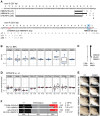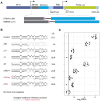This is a preprint.
Nonequivalence of Zfp423 premature termination codons in mice
- PMID: 40501617
- PMCID: PMC12157372
- DOI: 10.1101/2025.05.30.656936
Nonequivalence of Zfp423 premature termination codons in mice
Update in
-
Nonequivalence of Zfp423 premature termination codons in mice.Genetics. 2025 Aug 18:iyaf164. doi: 10.1093/genetics/iyaf164. Online ahead of print. Genetics. 2025. PMID: 40825037
Abstract
Genetic variants that introduce a premature termination codon (PTC) are often assumed equivalent and functionally null. Exceptions depend on the specific architectures of the affected mRNA and protein. Here we address phenotypic differences among early truncating variants of mouse Zfp423, whose phenotypes resemble Joubert Syndrome and Related Disorders (JSRD). We replicate quantitative differences previously seen between presumptive null PTC variants based on their position in the coding sequence. We show with reciprocal congenic strains that large phenotype differences between two PTC variants with the same predicted stop and reinitiation codons is due to the specific allele rather than different strain backgrounds, with no evidence for induced exon skipping. Differences in RNA structure, however, could influence translation rate across the affected exon. Using a reporter assay, we find differences in translational reinitiation between two deletion variants that corelate with predicted RNA structure rather than distance from the canonical initiation codon. These results confirm and extend earlier evidence for differences among Zfp423 PTC variants, identify parameters for translational reinitiation after an early termination codon, and reinforce caution in the null interpretation of early PTC variants.
Figures





Similar articles
-
Nonequivalence of Zfp423 premature termination codons in mice.Genetics. 2025 Aug 18:iyaf164. doi: 10.1093/genetics/iyaf164. Online ahead of print. Genetics. 2025. PMID: 40825037
-
Prescription of Controlled Substances: Benefits and Risks.2025 Jul 6. In: StatPearls [Internet]. Treasure Island (FL): StatPearls Publishing; 2025 Jan–. 2025 Jul 6. In: StatPearls [Internet]. Treasure Island (FL): StatPearls Publishing; 2025 Jan–. PMID: 30726003 Free Books & Documents.
-
Comparison of Two Modern Survival Prediction Tools, SORG-MLA and METSSS, in Patients With Symptomatic Long-bone Metastases Who Underwent Local Treatment With Surgery Followed by Radiotherapy and With Radiotherapy Alone.Clin Orthop Relat Res. 2024 Dec 1;482(12):2193-2208. doi: 10.1097/CORR.0000000000003185. Epub 2024 Jul 23. Clin Orthop Relat Res. 2024. PMID: 39051924
-
Systemic pharmacological treatments for chronic plaque psoriasis: a network meta-analysis.Cochrane Database Syst Rev. 2021 Apr 19;4(4):CD011535. doi: 10.1002/14651858.CD011535.pub4. Cochrane Database Syst Rev. 2021. Update in: Cochrane Database Syst Rev. 2022 May 23;5:CD011535. doi: 10.1002/14651858.CD011535.pub5. PMID: 33871055 Free PMC article. Updated.
-
Ataluren and similar compounds (specific therapies for premature termination codon class I mutations) for cystic fibrosis.Cochrane Database Syst Rev. 2017 Jan 19;1(1):CD012040. doi: 10.1002/14651858.CD012040.pub2. Cochrane Database Syst Rev. 2017. Update in: Cochrane Database Syst Rev. 2023 Mar 3;3:CD012040. doi: 10.1002/14651858.CD012040.pub3. PMID: 28102546 Free PMC article. Updated.
References
Publication types
Grants and funding
LinkOut - more resources
Full Text Sources
Research Materials
